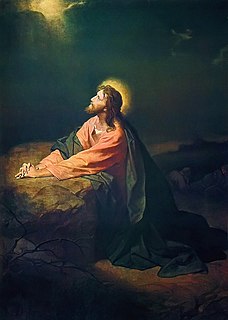 W
WThe Agony in the Garden of Gethsemane was an event in the life of Jesus from the New Testament, between the Farewell Discourse at the conclusion of the Last Supper and Jesus' arrest.
 W
WThe Annunciation, also referred to as the Annunciation to the Blessed Virgin Mary, the Annunciation of Our Lady, or the Annunciation of the Lord, is the Christian celebration of the announcement by the Archangel Gabriel to the Blessed Virgin Mary that she would conceive and become the mother of Jesus, the Jewish messiah and Son of God, marking His Incarnation. Gabriel told Mary to name her son Jesus, meaning "YHWH is salvation".
 W
WThe annunciation to the shepherds is an episode in the Nativity of Jesus described in the Bible in Luke 2, in which angels tell a group of shepherds about the birth of Jesus. It is a common subject of Christian art and of Christmas carols.
 W
WThe ascension of Jesus is Christian teaching that Christ physically departed from Earth by rising into Heaven, in the presence of eleven of his apostles. According to the New Testament narrative, the ascension occurred 40 days after the resurrection. In the Christian tradition, reflected in the major Christian creeds and confessional statements, God exalted Jesus after his death, raising him from the dead and taking him to Heaven, where Jesus took his seat at the right hand of God.
 W
WThe narrative of Bel and the Dragon is incorporated as chapter 14 of the extended Book of Daniel. The original Septuagint text in Greek survives in a single manuscript, Codex Chisianus, while the standard text is due to Theodotion, the 2nd-century AD revisor.
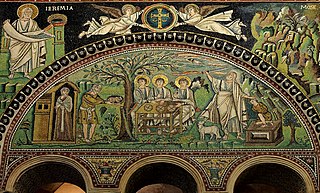 W
WThe Binding of Isaac Aqedat Yitzhaq, in Hebrew also simply "the Binding", הָעֲקֵידָה Ha-Aqedah, -Aqeidah) is a story from the Hebrew Bible found in Genesis 22. In the biblical narrative, God tells Abraham to sacrifice his son, Isaac, on Moriah. Abraham begins to comply, when a messenger from God interrupts him. Abraham then sees a ram and sacrifices it instead.
 W
WThe burning bush is an object described by the Book of Exodus as being located on Mount Horeb. According to the narrative, the bush was on fire, but was not consumed by the flames, hence the name. In the biblical narrative, the burning bush is the location at which Moses was appointed by God to lead the Israelites out of Egypt and into Canaan.
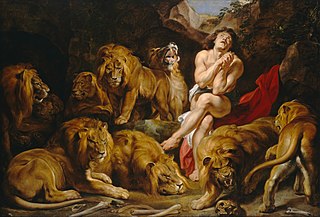 W
WDaniel in the lions' den tells of how the legendary Daniel is saved from lions by the God of Israel "because I was found blameless before him". It parallels and complements chapter 3, the story of Shadrach, Meshach, and Abednego: each begins with the jealousy of non-Jews towards successful Jews and an imperial edict requiring them to compromise their religion, and concludes with divine deliverance and a king who confesses the greatness of the God of the Jews and issues an edict of royal protection. The tales making up chapters 1–6 of Daniel are no earlier than the Hellenistic period and were probably originally independent, but were collected in the mid-2nd century BC and expanded shortly afterwards with the visions of the later chapters to produce the modern book.
 W
WThe empty tomb is the Christian tradition that on the morning of the first day of the week women followers of Jesus went to the place where he had been buried, where they found the body gone and the tomb occupied by angels. Beyond this the four gospels agree on very little. Mark, the earliest, ends with the women fleeing and telling no one what they have seen ; Matthew introduces guards and a curious doublet whereby the women are told twice, by the angels and then by Jesus, that he will meet the disciples in Galilee; Luke changes Mark's one "young man" to two, adds Peter's inspection of the tomb, and deletes the promise that Jesus would meet his disciples in Galilee; John introduces the "beloved disciple" who visits the tomb with Peter and understands its significance before Peter, and reduces the women to the solitary Mary Magdalene.
 W
WThe flight into Egypt is a story recounted in the Gospel of Matthew and in New Testament apocrypha. Soon after the visit by the Magi, an angel appeared to Joseph in a dream telling him to flee to Egypt with Mary and the infant Jesus since King Herod would seek the child to kill him. The episode is frequently shown in art, as the final episode of the Nativity of Jesus in art, and was a common component in cycles of the Life of the Virgin as well as the Life of Christ. Within the narrative tradition, iconic representation of the "Rest on the Flight into Egypt" developed after the 14th century.
 W
WIshmael, a figure in the Tanakh and the Quran, was Abraham's first son according to Jews, Christians and Muslims. Ishmael was born to Abraham and Sarah's Egyptian handmaiden Hagar (Hājar). According to the Genesis account, he died at the age of 137.
 W
WJacob wrestling with the angel is described in Genesis. The "angel" in question is referred to as "man" (אִישׁ) and "God" in Genesis, while Hosea references an "angel" (מַלְאָךְ). The account includes the renaming of Jacob as Israel.
 W
WJacob's Ladder is a ladder leading to heaven that was featured in a dream the biblical Patriarch Jacob had during his flight from his brother Esau in the Book of Genesis.
 W
WJohn 20:12 is the twelfth verse of the twentieth chapter of the Gospel of John in the New Testament of the Christian Bible. Mary Magdalene is peering into the empty tomb of Jesus and sees two angels.
 W
WJohn 20:13 is the thirteenth verse of the twentieth chapter of the Gospel of John in the New Testament of the Christian Bible. This verse occurs after Mary Magdalene has found Jesus' tomb empty, except for two angels.
 W
WThe liberation of the apostle Peter is an event described in the Acts of the Apostles, chapter 12 in which the apostle Peter is rescued from prison by an angel. Although described in a short textual passage, the tale has given rise to theological discussions and has been the subject of a number of artworks.
 W
WChrist's agony at Gethsemane is a passage in the Gospel of Luke (22:43–44), describing a prayer of Jesus, after which he receives strength from an angel, on the Mount of Olives prior to his betrayal and arrest. It is one of several passages which appear in most versions of the New Testament, but are absent in earlier manuscripts.
 W
WMatthew 1:20 is the twentieth verse of the first chapter in the Gospel of Matthew in the New Testament. Previously Joseph had found Mary to be pregnant and had considered leaving her. In this verse an angel comes to him in a dream and reassures him.
 W
WMatthew 1:21 is the twenty-first verse of the first chapter in the Gospel of Matthew in the New Testament. This verse contains one of the first mentions of Jesus. Joseph is being spoken to in a dream by an angel. In this verse the angel comes to him and tells him of the nature of his child.
 W
WMatthew 2:13 is the thirteenth verse of the second chapter of the Gospel of Matthew in the New Testament. The magi have left after paying homage to the young Jesus. In this verse an angel warns Joseph that he must flee.
 W
WMatthew 2:19 is the nineteenth verse of the second chapter of the Gospel of Matthew in the New Testament. King Herod has launched the Massacre of the Innocents in an attempt to kill the infant Jesus, but the Holy family having been warned have left for Egypt. In this verse Joseph is again contacted by an angel and told that it is safe to return.
 W
WMatthew 2:20 and 2:21 are the twentieth and twenty first verses of the second chapter of the Gospel of Matthew in the New Testament. The young Jesus and the Holy Family are in Egypt. An angel has just informed Joseph that King Herod, his persecutor, is dead. In this verse the angel gives him further instructions. The wording of this verse is extremely close to that of Exodus 4:19.
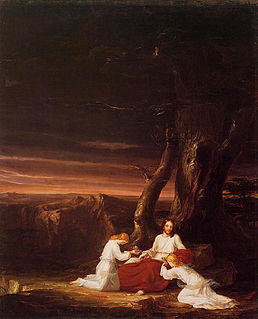 W
WMatthew 4:11 is the eleventh verse of the fourth chapter of the Gospel of Matthew in the New Testament. Jesus has just rebuffed Satan's third temptation and ordered him away. In this last verse of the temptation scene the devil departs and Jesus is serviced by angels.
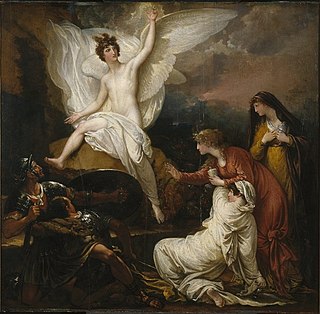 W
WMatthew 28:2 is the second verse of the twenty-eighth chapter of the Gospel of Matthew in the New Testament. This verse is part of the resurrection narrative. Mary Magdalene and "the other Mary" were approaching Jesus' tomb after the crucifixion, when an earthquake occurred and an angel appeared.
 W
WMatthew 28:3 is the third verse of the twenty-eighth chapter of the Gospel of Matthew in the New Testament. This verse is part of the resurrection narrative. This verse describes the angel that arrived at the tomb of Jesus in the previous verse.
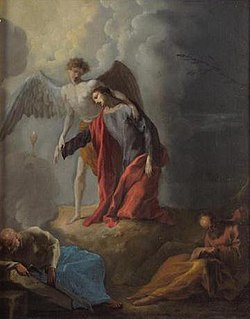 W
WMatthew 28:4 is the fourth verse of the twenty-eighth chapter of the Gospel of Matthew in the New Testament. This verse is part of the resurrection narrative; describing the reaction of the tomb guards after the arrival of the angel of the Lord and the occurrence of an earthquake that opened the tomb.
 W
WMatthew 28:5–6 are the fifth and sixth verses of the twenty-eighth chapter of the Gospel of Matthew in the New Testament of Christian Bible. This verse is part of the resurrection narrative. An angel has appeared at the empty tomb and in this verse he gives instructions to Mary Magdalene and "the other Mary".
 W
WMatthew 28:7 is the seventh verse of the twenty-eighth chapter of the Gospel of Matthew in the New Testament. This verse is part of the resurrection narrative. An angel has appeared at the empty tomb and in this verse he continues his instructions to Mary Magdalene and "the other Mary".
 W
WThe parable of the rich man and Lazarus is a well-known parable of Jesus appearing in the Gospel of Luke.
 W
WSaint Joseph's dreams are four dreams described in the Gospel of Matthew in the New Testament in which Joseph, the legal father of Jesus, is visited by an angel of the Lord and receives specific instructions and warnings of impending danger. All four dreams come from the period around the Nativity of Jesus and his early life, between the onset of Mary's pregnancy and the family's return from the Flight to Egypt. They are often distinguished by numbers as "Joseph's first dream" and so on. Especially in art history, the first may be referred to as the Annunciation to Joseph.
 W
WThe seven bowls are a set of plagues mentioned in Revelation 16. They are recorded as apocalyptic events that were seen in the vision of the Revelation of Jesus Christ, by John of Patmos. Seven angels are given seven bowls of God's wrath, each consisting of judgements full of the wrath of God. These seven bowls of God's wrath are poured out on the wicked and the followers of the Antichrist after the sounding of the seven trumpets.
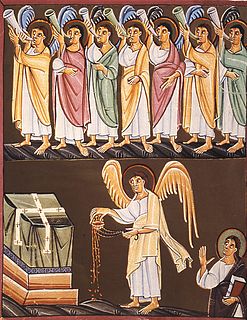 W
WIn the Book of Revelation, seven trumpets are sounded, one at a time, to cue apocalyptic events seen by John of Patmos in his vision. The seven trumpets are sounded by seven angels and the events that follow are described in detail from Revelation Chapters 8 to 11. According to Revelation 8:1–2 the angels sound these trumpets after the breaking of the seventh seal. These seals secured the apocalyptic document held in the right hand of Him who sits on the throne. The trumpets are referred to in Koine Greek as σάλπιγξ ; this was a straight, narrow bronze tube with a mouthpiece of bone and a bell; they do not resemble modern trumpets. The final three trumpets are sometimes called the "woe trumpets".
 W
WSodom and Gomorrah were two cities mentioned in the Book of Genesis and throughout the Hebrew Bible, the New Testament, and in the deuterocanonical books, as well as in the Quran and the hadith.
 W
WThe temptation of Christ is a biblical narrative detailed in the gospels of Matthew, Mark and Luke. After being baptized by John the Baptist, Jesus was tempted by the devil for 40 days and nights in the Judaean Desert. During this time, Satan came to Jesus and tried to tempt him. Jesus having refused each temptation, Satan then departed and Jesus returned to Galilee to begin his ministry. During this entire time of spiritual battle, Jesus was fasting.